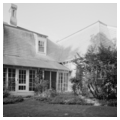You are here
Colonel George Waring House (The Hypotenuse)
This small cottage, now sited on the hypotenuse of the street corner and so named, was moved by Richard Morris Hunt from his family property on Bellevue Avenue and Church Street to this site and subsequently given sometime after 1876 to Colonel George Waring, a local engineer and author of technical manuals who helped establish Newport's sewage system. Only the four fluted Doric columns spanning the entry alcove indicate its Greek Revival origins. Everything else seems to be Hunt's 1870 envelopment of the kind of decorative vernacular image that he helped popularize in Newport during the 1860s and into the next decade—bonnet gable, deep eaves skirted with sawn tracery patterns, stickwork braces, and half-timbering effects. (Some of this detailing probably influenced the designer of the nearby Samuel Pratt House (NE115). In this area Hunt built most of his early Newport Stick Style houses.
Writing Credits
If SAH Archipedia has been useful to you, please consider supporting it.
SAH Archipedia tells the story of the United States through its buildings, landscapes, and cities. This freely available resource empowers the public with authoritative knowledge that deepens their understanding and appreciation of the built environment. But the Society of Architectural Historians, which created SAH Archipedia with University of Virginia Press, needs your support to maintain the high-caliber research, writing, photography, cartography, editing, design, and programming that make SAH Archipedia a trusted online resource available to all who value the history of place, heritage tourism, and learning.




